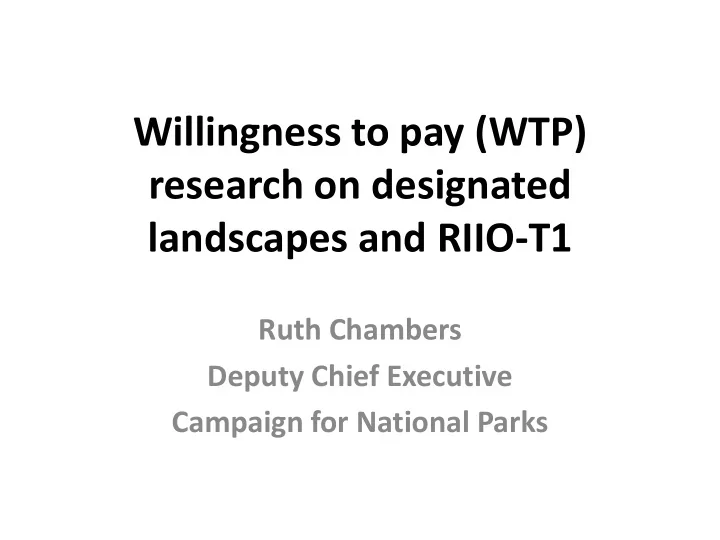

Willingness to pay (WTP) research on designated landscapes and RIIO-T1 Ruth Chambers Deputy Chief Executive Campaign for National Parks
Context (1) • Overarching principle is legal duty on statutory undertakers, including OFGEM and NGET to conserve and enhance protected areas • Reducing net visual ‘ disamenity ’ of transmission networks is a good substantive interpretation of that duty • This has been argued previously in TPCR4 but dismissed on the basis that it is not supported by WTP data. But the available data does not address the issue correctly…
Context (2) • Much has changed since TPCR4... • National Grid review of its approach to undergrounding • IET/KEMA study on the costs of undergrounding • Significant public and political interest in undergrounding
Lessons from DPCR4/DPCR5 • Recent price reviews for distribution have established and sustained an undergrounding for visual amenity (UVA) fund based on consumer WTP which has resulted in clear environmental benefits over wide areas • Even relatively small WTPs (representing a very minor part of consumer bills), when aggregated, provide significant funds for enhancements to national landscape assets
The eftec study (2006) • Commissioned to gather data for TPCR4 and based mainly on nearby householders, noting significant positive WTP • Noted lack of primary studies: ‘ it is difficult to escape the conclusion that more original valuation work is needed ’ • ‘ An assessment of whether the land in question has non- use value is also vital… some types of land such as national parks.. may be valued by individuals or households elsewhere …’
The ‘Cowell analysis’ (1) • Advice commissioned by Friends of the Lake District as part of input to TPCR4 • Meeting NP and AONB duties requires some substantive net improvement over time, not just at the point of planning applications • Higher costs of undergrounding transmission network affects only the lengths of line that can be addressed not the principle per se
The ‘Cowell analysis’ (2) • We don’t agree with OFGEM’s that undergrounding benefits are only local – they are significant landscape assets, used by millions, whose protection (by law) is always in the national interest and thus national WTP is appropriate (incorporating non-use values) • Establishing appropriate WTP values will create allowances (comparable to those for distribution) which will enable TOCs to meet, in a substantive way, their obligations under the 1995 and 2000 Acts
Summary & ways forward • Key issue is lack of appropriate research data on overall WTP for undergrounding transmission assets in NPs and AONBs, including visitor and non-use values. This must be rectified in TPCR5 • Even a modest positive WTP would aggregate nationally significant sums sufficient to take forward undergrounding of key routes • An indicator will be required to monitor compliance: this is simple and easily quantifiable
Recommend
More recommend